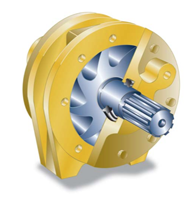 Rotary Seal Considerations
Rotary Seal Considerations Rotary Seal Considerations
Rotary Seal Considerations
Rotary seal applications offer unique challenges to seal manufacturers. Friction produced heat can quickly exceed the materials' maximum temperature if careful consideration is not made to minimize friction. Consider the following issues with rotary seal applications.
Heat Dissipation
The most common failure mode for a rotary seal is heat failure of the material. The most effective method of reducing heat build up is to reduce friction. This can be accomplished in many ways. Consider the chart below.
| Difficult to Seal | Easy to Seal |
| • High shaft speed • Non-lubricating seal medium • Loose component tolerances • Incorrect shaft surface finish • Insulating materials • High temperature • Pressure less than 10 psi • Pressure greater than 750 psi |
• Low shaft speed • Lubricating seal medium • Tight component tolerances • Correct surface finish • Conductive materials • Lower temperature • Pressure between 10 and 750 psi |
Mating Part Tolerance
To maintain a good seal with minimum friction, rotary applications require mating parts to be manufactured with tight tolerances. The shaft and bore should have a tolerance of ±.001 or better. Using tight tolerances reduces the amount of squeeze needed to seal in the worst case tolerance stackup.
Select Cross-section Size
When specifying a seal, choose the largest cross-section possible. The greater the cross-section, the more effective the seal and the longer the service life.
Shaft Speed
Whenever a choice exists, seal on the smallest diameter of the shaft to minimize friction and reduce surface speed.
Shaft speeds of 900 FPM (274.3 m/min) are possible in pressure lubricated hydraulic applications. For shaft speeds of less than 20 FPM (15.2 m/min) and greater than 900 FPM (274.3 m/min) please contact our engineering department for technical assistance.
Feet / Minute (FPM) =
Shaft diameter (in inches) x 3.1415 x RPM) / 12
Meters / Minute (m/min) =
Shaft diameter (in meters) x 3.1415 x RPM
Seal Lubrication
Because heat related failure is the most common rotary seal failure mode, seal lubrication is extremely important. As friction increases so does heat buildup, decreasing seal life. Every application is different, but with increased surface speed lubrication is increasingly important. Also consider it takes lubrication pressure to get the lubrication forced into the dynamic seal interface. This pressure needs to be a minimum of 10 psi. When sealing non-lubricating fluids (milk, water, air, etc.) the seal life will be reduced significantly.
Surface Finish and Hardness
To reduce friction, the surface finish of the shaft should ideally be 20-24 µin Ra (.5-.6 µm) to improve its lubrication holding ability; 20-32 µin Ra (.5-.7 µm) is acceptable. Having a surface finish that is too smooth stops lubrication from getting to the sealing surface. Surface finish in the groove should be 63-85 µin Ra (1.6-2.1 µm) to prevent the seal from rotating in the groove. The minimum recommended hardness for the shaft material is 35 Rc.
Peripheral Compression
In a rotary application, the inside diameter of a free, uninstalled, Quad-Ring® Brand seal should always be larger than the OD of the shaft. After installation, the inside diameter will be peripherally compressed to be small enough to provide the squeeze necessary for sealing. This holds the seal in the groove and makes the dynamic surface between the seal and the shaft, not between the seal and the groove.
Seal Movement
Placing the groove in the housing, peripherally compressing the seal into the groove, and maximizing component
concentricity maximizes seal life. Component eccentricity in rotary applications will cause the seal to act as a pump, causing the seal to leak.
Materials
Our compounds 525LP and 525L are recommended for rotary applications. These carboxylated nitrile formulations offer excellent abrasion resistance and are compatible for use with most hydraulic fluids. Compound 525LP is generally used in applications to 300 psi (20.7 bar), while 525L is preferred for pressures of 300-750 psi (20.7-51.7 bar).
Avoiding Seal Installation Damage
Seals can be easily damaged during installation. For example, a seal is often inserted onto a shaft by sliding it over a threaded or splined surface. To avoid seal damage, reduce the shaft diameter in the threaded region. Also include a lead-in chamfer for the seal and avoid sharp corners on grooves.When possible, consider using a cone-shaped installation tool to help install the seal.